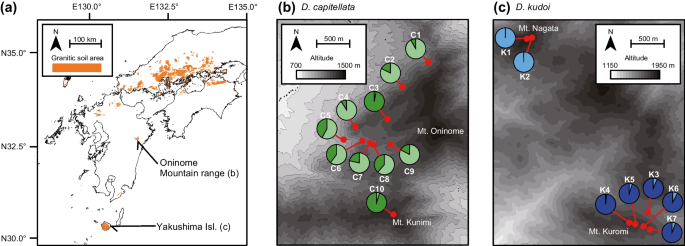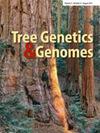Demographic history and conservation aspects of two relict shrubs (Daphnimorpha spp., Thymelaeaceae) showing disjunct and restricted distribution in the southern part of Japan
IF 1.6
3区 生物学
Q2 FORESTRY
引用次数: 0
Abstract
Abstract Climate relicts are of particular importance in evolutionary biology because of the strategies they may adopt for long-term survival despite climatic oscillations. However, because their current distribution is usually restricted and fragmented, many climatic relicts are at risk of extinction. Daphnimorpha (Thymelaeaceae) is a genus endemic to Japan that comprises two species ( D. capitellata and D. kudoi ) with a disjunct distribution in southern Japan. These two shrub species are endemic to a single mountain range. In this study, we conducted population genetic analyses using genome-wide single nucleotide polymorphisms obtained from multiplexed inter-simple sequence repeats genotyping by sequencing to reveal the phylogeographic history and obtain conservation implications for the two species. The results showed that these two species may have been isolated since the Tertiary period, supporting their status as climate relicts. In addition, D. kudoi showed clear genetic differentiation between the two mountains where it occurred (Mt. Nagata and Mt. Kuromi), with a decline in the effective population sizes inferred during the last glacial period. In contrast, D. capitellata showed no clear intraspecific genetic structure, and its effective population size was relatively stable. These differences could result in contrasting light tolerance between species. For conservation, we recommend managing these species as three evolutionarily significant units (ESUs): D. capitellata , D. kudoi population on Mt. Nagata, and D. kudoi population on Mt. Kuromi. Considering the limited gene flow among subpopulations and small population census, all ESUs require conservation attention to maintain or increase their effective population sizes.

日本南部两种残灌木(水蚤科,百里香科)的分布与保护
气候遗迹在进化生物学中具有特别重要的意义,因为它们可能在气候波动的情况下采取长期生存的策略。然而,由于它们目前的分布通常受到限制和分散,许多气候遗迹面临灭绝的危险。Daphnimorpha (thymelae科)是日本特有的一个属,由两种(D. capitellata和D. kudoi)组成,在日本南部有间断分布。这两种灌木是同一山脉特有的。在这项研究中,我们利用测序获得的多重简单序列重复基因分型获得的全基因组单核苷酸多态性进行群体遗传分析,以揭示两个物种的系统地理历史并获得保护意义。结果表明,这两个物种可能在第三纪就已经分离,支持了它们作为气候遗迹的地位。此外,在长田山和黑尾山这两座高山之间,黑尾山的有效种群数量在末次冰期有所下降,显示出明显的遗传分化。小头草没有明显的种内遗传结构,有效种群大小相对稳定。这些差异可能导致不同物种之间的光耐受性差异。为了保护这些物种,我们建议将它们作为三个进化显著单位(esu)进行管理:D. capitellata、D. kudoi在长田山的种群和D. kudoi在黑罗米山的种群。考虑到亚群间的基因流动有限和种群普查规模小,所有esu都需要注意保护,以保持或增加其有效种群规模。
本文章由计算机程序翻译,如有差异,请以英文原文为准。
求助全文
约1分钟内获得全文
求助全文
来源期刊

Tree Genetics & Genomes
生物-林学
CiteScore
4.40
自引率
4.20%
发文量
38
审稿时长
2 months
期刊介绍:
Tree Genetics and Genomes is an international, peer-reviewed journal, which provides for the rapid publication of high quality papers covering the areas of forest and horticultural tree genetics and genomics.
Topics covered in this journal include:
Structural, functional and comparative genomics
Evolutionary, population and quantitative genetics
Ecological and physiological genetics
Molecular, cellular and developmental genetics
Conservation and restoration genetics
Breeding and germplasm development
Bioinformatics and databases
Tree Genetics and Genomes publishes four types of papers:
(1) Original Paper
(2) Review
(3) Opinion Paper
(4) Short Communication.
 求助内容:
求助内容: 应助结果提醒方式:
应助结果提醒方式:


